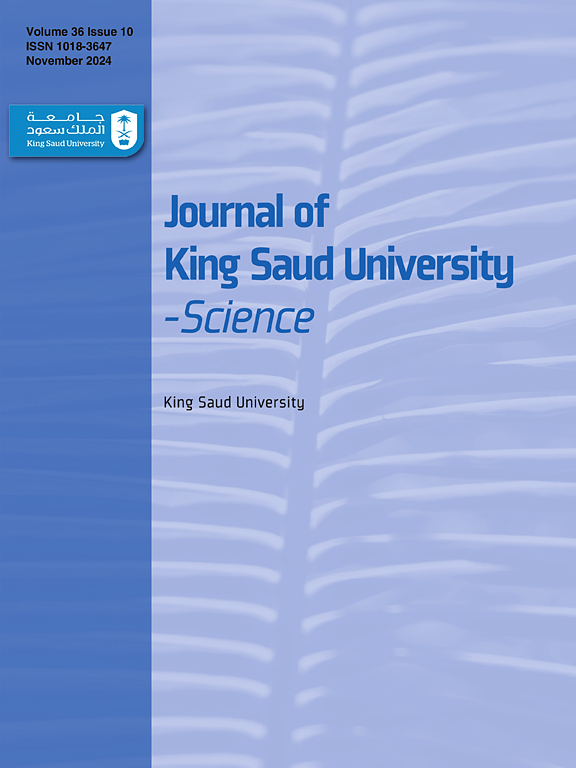铜绿假单胞菌菌株PA01结合铜和铬对重金属解毒和土壤修复的影响:计算方法
IF 3.6
3区 综合性期刊
Q1 MULTIDISCIPLINARY SCIENCES
引用次数: 0
摘要
由于铜和铬等金属在浓度升高时的毒性作用,重金属污染对环境和健康构成重大风险。尽管这些微量金属具有重要作用,但它们可能具有剧毒。铜绿假单胞菌等细菌由于其稳健性和适应性而成为生物修复的有希望的候选者。本研究的目的是分析和鉴定铜绿假单胞菌PA01中参与金属解毒的潜在铜和铬结合基因。利用MALDI-TOF/PMF-MS进一步鉴定重金属结合蛋白为铁氧还蛋白。利用SWISS-MODEL工具分析了铁氧还蛋白的结构。通过使用ScanProsite工具对UniProtKB/Swiss-Prot和UniProtKB/TrEMBL数据库进行模式搜索来验证金属结合结构域。对铜绿假单胞菌铜结合NosD基因、铜绿假单胞菌PA01铁氧还蛋白基因和铬还原梭菌铁结合氢化酶1基因进行了比较序列比对。SWISS-MODEL分析显示α螺旋和β薄片具有关键的金属配位氨基酸(半胱氨酸、谷氨酸、天冬氨酸、组氨酸和蛋氨酸)。ScanProsite工具证实了4Fe-4S铁还原蛋白型铁硫结合域的存在,这对铬和铜离子的配位至关重要。序列比对显示,NosD基因与铁氧还蛋白基因的相似性为64.29%,铁氢化酶1基因与铁氧还蛋白基因的相似性为67%,且与金属结合相关的氨基酸残基存在相关性。这些发现表明,铁氧还蛋白基因可以有效结合重金属离子,在利用假单胞菌修复金属污染土壤方面具有潜在的应用前景。该研究有助于通过生物手段对重金属污染土壤进行有针对性的修复,从而促进农业生产力的可持续发展。本文章由计算机程序翻译,如有差异,请以英文原文为准。

Copper and chromium binding by Pseudomonas aeruginosa strain PA01 for implications of heavy metal detoxification and soil remediation: A computational approach
Heavy metal pollution poses significant environmental and health risks due to the toxic effects of metals like copper and chromium at elevated concentrations. Despite their essential roles in trace amounts, these metals can be highly toxic. Bacteria such as Pseudomonas aeruginosa are promising candidates for bioremediation due to their robustness and adaptability. The objective of this study was to analyze and identify potential copper and chromium binding genes involved in metal detoxification in Pseudomonas aeruginosa PA01. The heavy metal binding protein identified as ferredoxin using MALDI-TOF/PMF-MS analysis was further characterized. The structure of the ferredoxin protein was elucidated using the SWISS-MODEL tool. Metal-binding domains were validated through a pattern search against UniProtKB/Swiss-Prot and UniProtKB/TrEMBL databases using the ScanProsite tool. Comparative sequence alignments were conducted between the copper-binding NosD gene of P. aeruginosa, the ferredoxin gene of P. aeruginosa PA01, and the chromium-binding iron hydrogenase 1 gene of Clostridium chromiireducens. The SWISS-MODEL analysis revealed alpha helices and beta sheets with key metal-coordinating amino acids (cysteine, glutamic acid, aspartic acid, histidine, and methionine). The ScanProsite tool confirmed the presence of a 4Fe-4S ferredoxin-type iron-sulphur binding domain essential for coordinating chromium and copper ions. Sequence alignments showed a 64.29 % similarity between the NosD gene and ferredoxin gene, and a 67 % identity between the iron hydrogenase 1 gene and ferredoxin gene, with correlations in amino acid residues involved in metal binding. These findings suggest that the ferredoxin gene could effectively bind heavy metal ions, offering potential applications in bioremediation of metal-polluted soils using Pseudomonas species. This study contributes to sustainable agricultural productivity by facilitating the targeted remediation of heavy metal-contaminated soils through biological means.
求助全文
通过发布文献求助,成功后即可免费获取论文全文。
去求助
来源期刊

Journal of King Saud University - Science
Multidisciplinary-Multidisciplinary
CiteScore
7.20
自引率
2.60%
发文量
642
审稿时长
49 days
期刊介绍:
Journal of King Saud University – Science is an official refereed publication of King Saud University and the publishing services is provided by Elsevier. It publishes peer-reviewed research articles in the fields of physics, astronomy, mathematics, statistics, chemistry, biochemistry, earth sciences, life and environmental sciences on the basis of scientific originality and interdisciplinary interest. It is devoted primarily to research papers but short communications, reviews and book reviews are also included. The editorial board and associated editors, composed of prominent scientists from around the world, are representative of the disciplines covered by the journal.
 求助内容:
求助内容: 应助结果提醒方式:
应助结果提醒方式:


